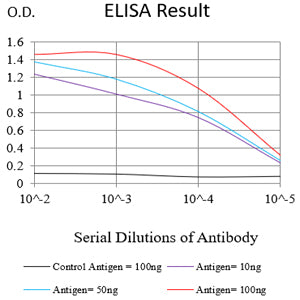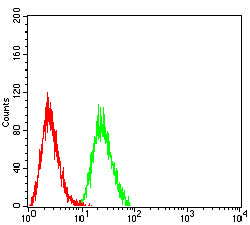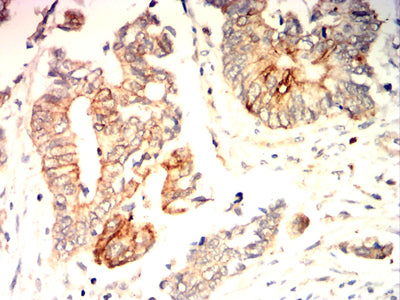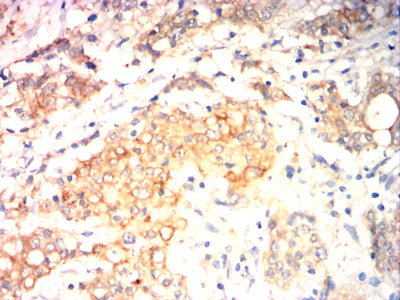




| WB | 1/500 - 1/2000 | Human,Mouse,Rat |
| IF | 咨询技术 | Human,Mouse,Rat |
| IHC | 1/200 - 1/1000 | Human,Mouse,Rat |
| ICC | 技术咨询 | Human,Mouse,Rat |
| FCM | 1/200 - 1/400 | Human,Mouse,Rat |
| Elisa | 1/10000 | Human,Mouse,Rat |
| Entrez GeneID | 7408 |
| clone | 6H6D11 |
| WB Predicted band size | 39.8kDa |
| Host/Isotype | Mouse IgG1 |
| Antibody Type | Primary antibody |
| Storage | Store at 4°C short term. Aliquot and store at -20°C long term. Avoid freeze/thaw cycles. |
| Species Reactivity | Human |
| Immunogen | Purified recombinant fragment of human VASP (AA: 1-380) expressed in E. Coli. |
| Formulation | Purified antibody in PBS with 0.05% sodium azide |
+ +
以下是关于VASP抗体的3篇参考文献及其简要摘要:
---
1. **文献名称**:*"Characterization of VASP phosphorylation and its role in platelet activation"*
**作者**:Smolenski, A., et al. (1998)
**摘要**:该研究利用特异性VASP抗体分析了cAMP/cGMP依赖性磷酸化对VASP蛋白功能的影响,揭示了其在抑制血小板聚集和细胞骨架重塑中的调控机制。
---
2. **文献名称**:*"VASP localization in focal adhesions and cell-cell junctions requires specific antibody recognition"*
**作者**:Haffner, C., et al. (1995)
**摘要**:通过免疫荧光技术结合VASP抗体,研究发现VASP定位于粘着斑和细胞连接处,提示其参与细胞黏附与迁移的分子调控。
---
3. **文献名称**:*"VASP interaction with profilin and its implications for actin dynamics"*
**作者**:Drees, B., et al. (2000)
**摘要**:该文献利用VASP抗体进行免疫共沉淀实验,证实VASP与profilin的相互作用对肌动蛋白聚合的时空调控至关重要,影响细胞运动与形态变化。
---
这些文献展示了VASP抗体在细胞生物学研究中的关键应用,涵盖功能分析、定位研究和蛋白相互作用等领域。如需更多文献或具体应用场景的推荐,可进一步说明需求。
VASP (Vasodilator-Stimulated Phosphoprotein) antibodies are tools used to study the role of VASP, a key regulatory protein involved in actin cytoskeleton dynamics and cell motility. VASP, first identified in platelets, is phosphorylated in response to cAMP- and cGMP-dependent signaling pathways, mediating cellular processes such as adhesion, migration, and immune response. It interacts with profilin and Ena/VASP family proteins to regulate actin polymerization, focal adhesion assembly, and cell polarity. Dysregulation of VASP is linked to cardiovascular diseases, cancer metastasis, and immune disorders.
VASP antibodies are widely employed in biomedical research to detect and quantify VASP expression, phosphorylation status (e.g., Ser157. Ser239), and subcellular localization. They are essential in techniques like Western blotting, immunofluorescence, and immunoprecipitation, enabling investigations into platelet activation, endothelial barrier function, and tumor cell invasion. Specific monoclonal and polyclonal antibodies help distinguish between phosphorylated and non-phosphorylated forms, providing insights into cyclic nucleotide signaling pathways. Clinically, VASP phosphorylation assays serve as biomarkers for antiplatelet therapy efficacy. These antibodies thus bridge molecular mechanisms to pathophysiological studies, aiding drug development and diagnostic strategies.
×